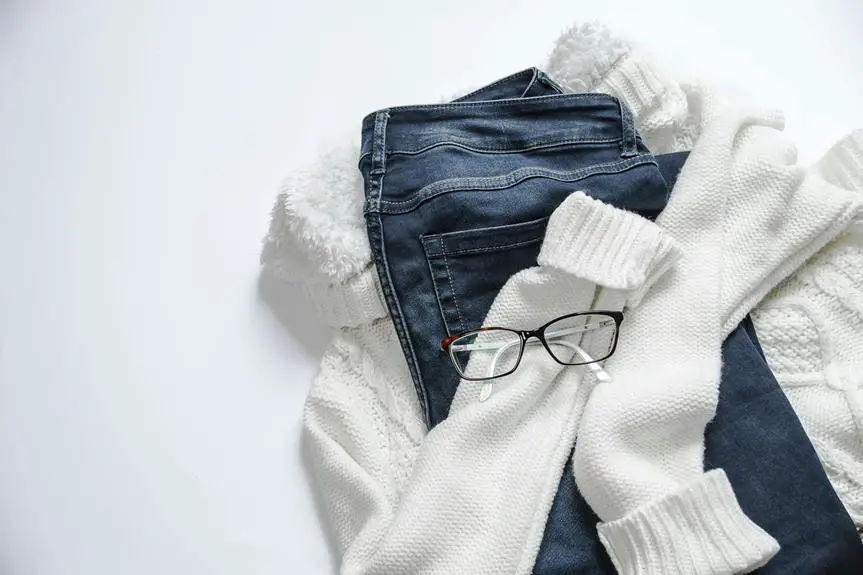When you choose microfleece, you're likely looking for warmth and comfort, but have you considered how it holds up to frequent washing? While the polyester fibers offer durability, repeated laundering can lead to pilling and a decline in softness. You might notice that those vibrant colors tend to fade over time, and the fabric's insulating properties can become compromised. So, what can you do to maintain that cozy feel and vibrant look? Let's explore some effective strategies for preserving your microfleece's quality.
Table of Contents
Understanding Microfleece Fabric
What makes microfleece so popular is its lightweight warmth and soft texture, which you'll find in many outdoor and active wear garments. The fabric is crafted from polyester fibers, creating a brushed surface that traps heat. This unique construction means you stay cozy without feeling bulky, an ideal feature for layering.
Microfleece is highly breathable, ensuring you won't overheat during intense activities. It wicks moisture away from your skin, keeping you dry and comfortable. Plus, it dries quickly, which is a huge plus after washing or if you get caught in the rain.
You'll also appreciate its versatility; whether you're hiking, running, or lounging at home, microfleece works well in various settings. Its lightweight nature and soft touch make it a favorite among those who value comfort during their adventures.
Another point to note is that microfleece is generally easy to care for, making it a practical choice for your active lifestyle. By choosing this fabric, you're embracing a cozy, functional option that meets both your comfort needs and your love for exploration.
Durability of Microfleece
When you consider the durability of microfleece, you'll find that the fabric's composition plays a crucial role.
Plus, the washing techniques you use can greatly influence its lifespan.
Understanding these factors helps you maintain your microfleece garments effectively.
Fabric Composition Impact
The durability of microfleece largely hinges on its fabric composition, which often includes polyester fibers that resist wear and maintain softness over time. When you choose a microfleece product, it's essential to know what materials are involved and how they affect the fabric's longevity.
- Fiber Type: Polyester is the primary material, known for its resilience against fading or fraying. Its dominance in the composition determines how long your microfleece item will last.
- Filament Thickness: Thinner filaments weave more tightly, increasing durability and softness while decreasing the likelihood of pilling.
- Blends: Sometimes, microfleece is blended with materials like spandex, which enhances stretch and helps the fabric withstand regular use.
- Finish Treatments: Anti-static or water-repellent treatments can improve performance, ensuring your microfleece stays effective through multiple washes.
Understanding these factors helps you appreciate why some microfleece options may last longer than others. By examining the fabric composition, you can make informed choices and enjoy your microfleece garments for years to come.
Washing Techniques Influence
Improper washing techniques can significantly reduce the durability of your microfleece garments, making it crucial to follow care instructions closely.
First, always wash your microfleece in cold water. Hot water can cause the fabric to lose its softness and shape, leading to premature wear.
Next, avoid using fabric softeners and dryer sheets. These products can leave a residue, making the fabric less breathable and diminishing its insulating properties.
Instead, use a mild detergent that's free from additives.
When it comes to drying, opt for air drying whenever possible. If you need to use a dryer, select a low heat setting. High heat can damage the fibers, leading to pilling and a rough texture over time.
Effects of Frequent Washing
Frequent washing of microfleece can lead to pilling and a noticeable decline in softness over time. When you wash your microfleece too often, you may begin to notice some unwanted effects.
- Pilling: Repeated friction during washing and drying causes small fibers to break off, creating those pesky little balls on the fabric's surface.
- Loss of Softness: The fabric may feel less plush, as the fibers degrade with each wash, leading to a rougher texture.
- Color Fading: Excessive washing can also fade the vibrant colors of microfleece, making your once-bright items appear dull and lifeless.
- Decreased Insulation: With each wash, the insulating abilities of microfleece can suffer, reducing its effectiveness in keeping you warm and cozy.
To prolong its lifespan, you should limit how often you wash your microfleece and choose gentler washing methods. Keeping these effects in mind can help you maintain your microfleece's quality for longer, ensuring it stays a staple in your wardrobe.
Maintaining Microfleece Quality
To keep your microfleece looking and feeling its best, you should care for it with a few simple maintenance tips. First, storage plays a crucial role; always fold it neatly and avoid hanging, as this can stretch the fabric. Make sure to keep it in a cool, dry place to prevent any moisture buildup that could lead to mildew.
When it comes to wear, be mindful of where you're wearing your microfleece. Avoid activities that might cause excessive friction or snagging, like rough outdoor sports.
Regularly check for pilling and gently remove any pills with a fabric shaver or lint roller to maintain a smooth surface.
Next, pay attention to lint. To prevent lint buildup, try to wash it separately from items that shed lint excessively, such as towels or cotton clothes.
Lastly, if you notice your microfleece losing its softness or warmth, it may be time to refresh it with a fabric softener that's compatible with synthetic fibers.
Tips for Washing Microfleece
Washing microfleece the right way helps maintain its softness and shape, ensuring it stays comfortable for years to come.
- Use Cold Water: Always wash microfleece in cold water to avoid fabric damage and shrinkage. Hot water can break down the fibers over time.
- Gentle Cycle: Opt for a gentle cycle on your washing machine. This minimizes wear and tear, preserving the fabric's integrity while still getting it clean.
- Mild Detergent: Choose a mild detergent free of bleach or fabric softeners. Harsh chemicals can strip the microfleece of its natural softness.
- Air Dry or Low Heat: Whenever possible, air dry your microfleece items. If you need to use a dryer, set it to low heat. High temperatures can cause the fibers to lose their shape.
Long-term Care Recommendations
To keep your microfleece in top shape, it's essential to follow proper washing techniques.
You should also pay attention to drying best practices to prolong its lifespan.
Let's explore how these simple steps can make a real difference.
Proper Washing Techniques
Since microfleece is prone to pilling, it's essential to follow specific washing techniques to maintain its softness and durability over time. By adopting proper washing habits, you can extend the life of your microfleece garments.
- Use Cold Water: Always opt for cold water when washing microfleece. This helps prevent fibers from breaking down and minimizes pilling.
- Gentle Cycle: Set your washing machine to a gentle cycle. This reduces agitation and protects the fabric from unnecessary wear and tear.
- Mild Detergent: Choose a mild, liquid detergent without bleach. Harsh chemicals can damage the fabric and contribute to fading over time.
- Avoid Fabric Softeners: Fabric softeners can create a buildup on microfleece, leading to reduced breathability and longevity. Skip them to keep your microfleece performing at its best.
Following these techniques will help you preserve the quality of your microfleece, ensuring it remains soft, warm, and comfortable wash after wash. Proper care means your favorite microfleece pieces will last longer.
Drying Best Practices
Drying your microfleece properly is crucial for maintaining its softness and preventing damage over time. Following the right methods ensures your fleece remains cozy and functional after repeated washes. Here are some best practices to consider:
| Drying Method | Recommendations |
|---|---|
| Tumble Dry | Use a low heat setting to avoid overheating and damaging fibers. Remove while slightly damp to allow for air drying. |
| Air Dry | Hang your microfleece in a well-ventilated area, away from direct sunlight, to prevent color fading and fabric degradation. |
| Avoid Dry Cleaning | Microfleece isn't suitable for dry cleaning, as solvents can break down the fibers. Stick to simple washing and drying methods. |
| No Fabric Softeners | These can build up and affect the microfleece's moisture-wicking properties. Stick to mild detergents for the best results. |
Using these drying methods will help extend your microfleece's lifespan, keeping it looking great for many seasons. Remember, taking care of how you dry your fleece is just as important as how you wash it.
Frequently Asked Questions
Can Microfleece Be Ironed After Washing?
You shouldn't iron microfleece after washing; it's designed to be low-maintenance. Ironing can damage the fabric and reduce its insulating properties. Instead, you can hang or lay it flat to dry smoothly.
Does Microfleece Retain Odors After Multiple Washes?
Microfleece typically doesn't retain odors after multiple washes. You've got to make sure you wash it properly, though. Using the right detergent and avoiding fabric softeners can keep it smelling fresh and clean.
Is Microfleece Suitable for Sensitive Skin?
Microfleece is generally suitable for sensitive skin due to its soft texture and breathability. You'll likely find it comfortable, but it's wise to test a small area first, especially if you have known sensitivities.
How Does Microfleece Compare to Other Fabrics After Washing?
Microfleece generally retains its softness and shape better than many other fabrics after washing. It won't pill as easily as cotton, making it a reliable choice for comfort and durability in your wardrobe.
Can Microfleece Lose Its Warmth Over Time?
Yes, microfleece can lose some warmth over time, especially with frequent wear and washing. However, proper care can help maintain its insulating properties, allowing you to enjoy its warmth for a longer duration.
- How Does Ring Spun Cotton Affect Garment Fit and Shape Retention? - August 13, 2024
- What Are the Challenges in Producing Ring Spun Cotton? - August 13, 2024
- Is Ring Spun Cotton Suitable for Plus-Size Clothing? - August 13, 2024







